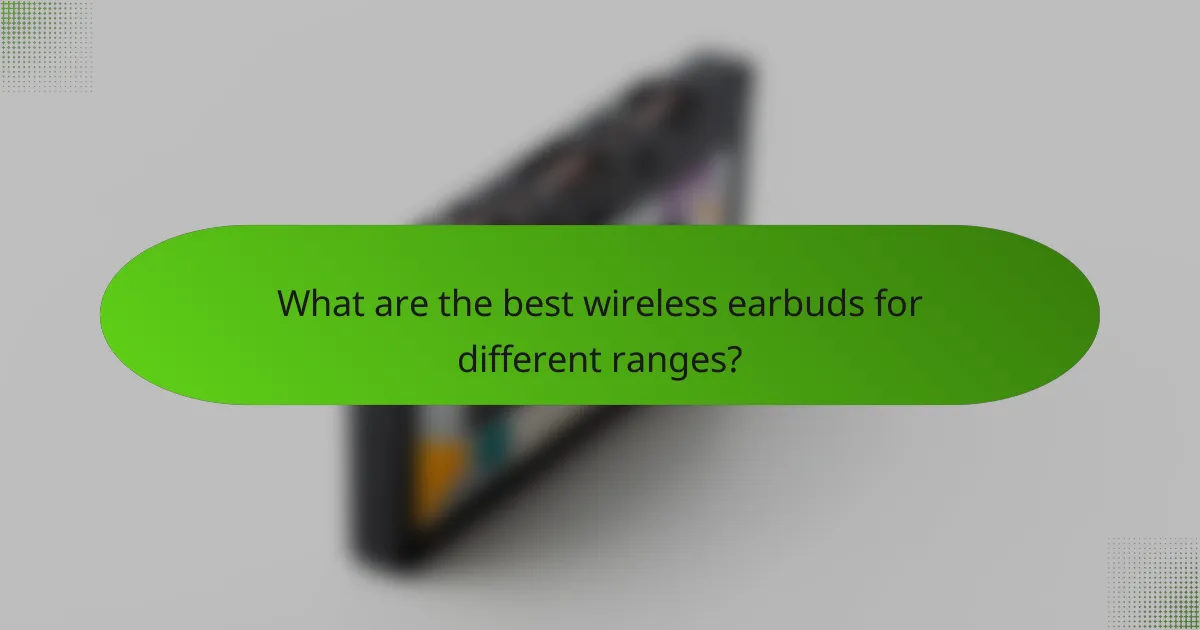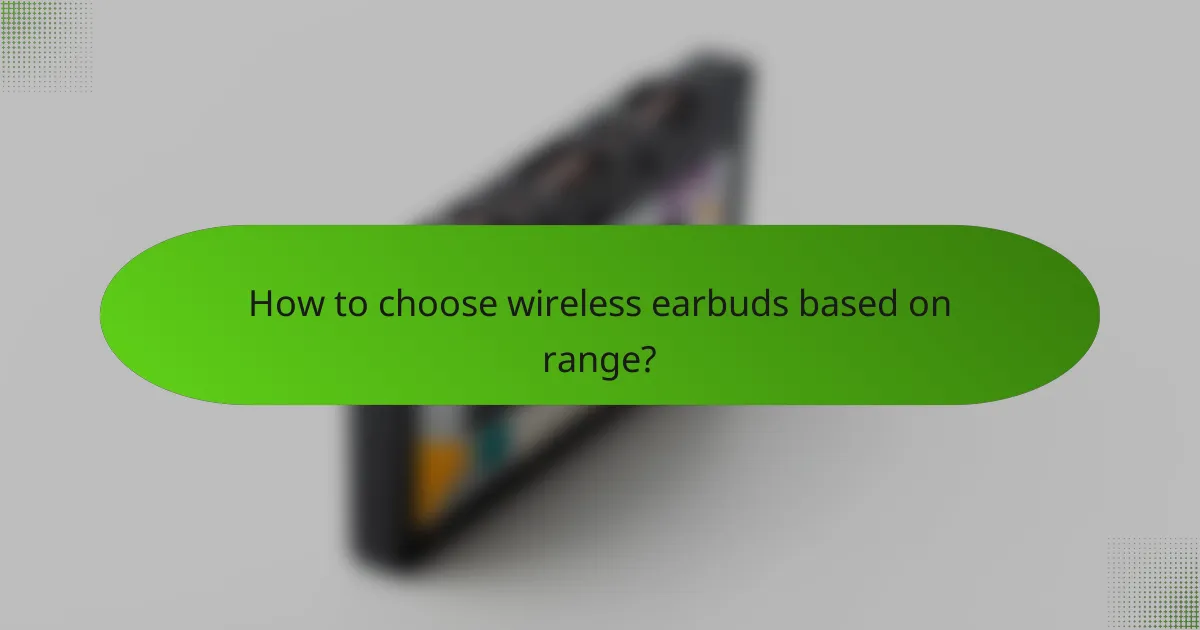The range of wireless earbuds plays a crucial role in shaping the user experience, as it dictates how far users can move from their connected devices without sacrificing audio quality or connectivity. A wider range offers enhanced freedom of movement, but may also present challenges in sound fidelity and stability. Selecting the right earbuds based on their range is essential for optimizing performance in various settings, whether for casual listening, workouts, or professional use.

How does range affect wireless earbuds user experience?
The range of wireless earbuds significantly impacts user experience by determining how far one can move away from the connected device without losing audio quality or connection. A greater range allows for more freedom of movement, but it can also introduce challenges related to sound quality and connectivity stability.
Sound quality variations
Sound quality in wireless earbuds can degrade as the distance from the audio source increases. Users may experience interruptions or a drop in audio fidelity when moving beyond the optimal range, typically around 10 to 30 meters, depending on the model and environment.
Obstacles like walls or furniture can further diminish sound quality, leading to a muffled or distorted listening experience. It’s advisable to test earbuds in various settings to understand their effective range and sound performance.
Comfort and fit differences
While range mainly pertains to connectivity, the comfort and fit of wireless earbuds can influence how users interact with them at different distances. For instance, if users frequently move away from their device, they might prefer a more secure fit to prevent earbuds from falling out during movement.
Choosing earbuds with adjustable tips or wings can enhance comfort and stability, especially when engaging in activities like running or exercising. A good fit ensures that users can enjoy their audio without constantly readjusting their earbuds.
Battery life implications
The range of wireless earbuds can affect battery life, as maintaining a connection over longer distances may require more power. Generally, earbuds have a battery life of several hours, but this can decrease if users are consistently operating at the edge of their range.
To maximize battery life, users should stay within the recommended range and turn off their earbuds when not in use. Some models offer quick charging features, which can be beneficial for users who frequently use their earbuds throughout the day.
Connectivity stability
Connectivity stability is crucial for an uninterrupted audio experience, and range plays a key role in this aspect. As users move further from the source device, the likelihood of experiencing dropouts or lag increases, particularly in environments with interference from other wireless devices.
To ensure stable connectivity, users should be aware of their earbuds’ effective range and avoid moving through areas with many obstacles. Regularly updating firmware can also help improve connectivity performance and address any known issues.

What are the best wireless earbuds for different ranges?
The best wireless earbuds vary by range, impacting user experience significantly. Whether you need earbuds for casual listening, workouts, or professional use, understanding the range can help you choose the right model.
Apple AirPods Pro 2
The Apple AirPods Pro 2 are designed for users who prioritize seamless integration with Apple devices and a reliable range. They typically offer a wireless range of about 30 meters in open spaces, making them suitable for everyday use without frequent disconnections.
These earbuds feature active noise cancellation and spatial audio, enhancing the listening experience. Users should consider that the range may decrease in environments with many obstacles, such as walls or furniture.
Samsung Galaxy Buds 2 Pro
The Samsung Galaxy Buds 2 Pro provide a competitive wireless range of approximately 30 meters, similar to the AirPods Pro 2. They are particularly effective for Samsung device users, offering features like 360 Audio for an immersive experience.
When using these earbuds, users should be aware that the range can be affected by interference from other wireless devices. It’s advisable to keep the connected device within sight for optimal performance.
Sony WF-1000XM4
The Sony WF-1000XM4 earbuds excel in sound quality and noise cancellation, with a wireless range of around 10 to 20 meters. They are ideal for audiophiles who value high-fidelity sound and want to enjoy music without interruptions.
However, users should note that the range may be less than that of competitors in open areas. To maximize performance, it’s best to use them in environments with minimal interference, ensuring a stable connection throughout the listening experience.

How to choose wireless earbuds based on range?
Choosing wireless earbuds based on range involves understanding how distance affects connectivity and sound quality. Look for earbuds with a range that suits your typical usage environment, whether that’s indoors or outdoors.
Consider sound isolation needs
Sound isolation is crucial for an immersive listening experience. If you often use earbuds in noisy environments, opt for models that offer good passive or active noise cancellation to block out background sounds.
For example, earbuds with silicone tips can provide better sound isolation compared to those with standard foam tips. Consider your daily activities and choose accordingly to ensure you can enjoy your audio without distractions.
Evaluate battery life requirements
Battery life is a key factor when selecting wireless earbuds, especially if you plan to use them for extended periods. Most earbuds offer anywhere from 4 to 10 hours of playback on a single charge, with additional charges available from the case.
Consider how often you’ll be using them without access to charging. If you frequently travel or spend long hours away from power sources, look for models that offer longer battery life or quick charging features.
Assess fit and comfort preferences
Fit and comfort are essential for prolonged use of wireless earbuds. Different models come with various ear tip sizes and shapes, which can significantly impact how they feel during extended listening sessions.
Try on different styles to find the best fit for your ears. Some users prefer in-ear designs for a snug fit, while others may opt for more open styles that rest outside the ear canal. Comfort is subjective, so prioritize what feels best for you during your typical usage scenarios.

What are the limitations of wireless earbuds range?
The range of wireless earbuds is primarily limited by interference, distance from the source device, and environmental factors. Understanding these limitations can help users optimize their listening experience and avoid connectivity issues.
Interference from other devices
Wireless earbuds often operate on the same frequency bands as other devices, such as Wi-Fi routers and microwaves. This interference can lead to dropouts or reduced sound quality. To minimize this issue, keep your earbuds away from other electronic devices when in use.
Common sources of interference include Bluetooth devices, Wi-Fi networks, and even physical barriers like walls. Users should be aware that using earbuds in crowded areas with many wireless signals can degrade performance.
Distance from source device
The effective range of wireless earbuds typically falls between 10 to 30 meters, depending on the model and environment. As you move further from the source device, the connection may weaken, leading to audio lag or disconnection. Staying within this range is crucial for optimal performance.
To maintain a stable connection, keep your smartphone or audio source within a reasonable distance. If you notice interruptions, consider moving closer to the device or reducing obstacles in between.
Environmental factors
Environmental conditions can significantly impact the performance of wireless earbuds. Factors like walls, furniture, and even human bodies can obstruct the Bluetooth signal, reducing range and audio quality. Open spaces tend to provide better connectivity than crowded or enclosed areas.
Weather conditions, such as heavy rain or extreme temperatures, can also affect wireless performance. For outdoor use, ensure that your earbuds are rated for such conditions to avoid damage and connectivity issues.

What are the emerging trends in wireless earbuds technology?
Emerging trends in wireless earbuds technology focus on enhancing user experience through innovations in sound quality, battery life, and connectivity. These advancements aim to provide users with more personalized audio experiences and seamless integration with devices.
Adaptive sound technology
Adaptive sound technology allows wireless earbuds to automatically adjust audio settings based on the user’s environment. For example, when in a noisy area, the earbuds can enhance voice clarity while reducing background noise, providing a more immersive listening experience.
This technology often uses built-in microphones to detect ambient sounds and adjust the sound profile accordingly. Users should look for earbuds that feature this capability, especially if they frequently transition between different environments, such as commuting or working in a café.
Extended battery life innovations
Extended battery life innovations are crucial for enhancing the usability of wireless earbuds. Many models now offer battery life ranging from several hours to over a day with charging cases, allowing for prolonged use without frequent recharging.
When choosing earbuds, consider those that provide quick charging features, enabling users to gain several hours of playback time from just a short charging session. This is particularly beneficial for users who are always on the go.
Improved connectivity protocols
Improved connectivity protocols, such as Bluetooth 5.0 and beyond, enhance the performance of wireless earbuds by offering faster pairing, greater range, and more stable connections. These advancements reduce latency and improve audio quality, making for a better listening experience.
When selecting wireless earbuds, prioritize models that support the latest Bluetooth standards, as they will generally provide a more reliable connection and compatibility with a wider range of devices. This is especially important for users who enjoy gaming or watching videos, where audio sync is critical.

How will future developments impact wireless earbuds range?
Future advancements in wireless technology are expected to significantly enhance the range of wireless earbuds. Innovations in Bluetooth protocols, antenna design, and battery efficiency will likely lead to improved connectivity and user experience.
Advancements in Bluetooth Technology
New Bluetooth versions, such as Bluetooth 5.0 and beyond, offer increased range and stability. These updates can extend the operational distance of wireless earbuds from around 10 meters to potentially 30 meters or more in optimal conditions. This means users can enjoy better connectivity even when moving away from their audio source.
Additionally, advancements like Bluetooth Low Energy (BLE) allow for longer battery life while maintaining a stable connection. This is particularly beneficial for users who rely on their earbuds for extended periods without frequent recharging.
Improved Antenna Design
Future wireless earbuds may incorporate advanced antenna technologies, such as phased array antennas, which can enhance signal reception and transmission. This improvement can reduce dropouts and maintain audio quality over greater distances.
Moreover, the placement and orientation of antennas within the earbuds can be optimized for better performance. Users should look for models that advertise superior antenna designs for a more reliable listening experience.
Battery Efficiency and Power Management
As battery technology evolves, wireless earbuds will likely feature longer-lasting batteries that support extended range capabilities. Efficient power management systems can help maintain connectivity without draining the battery quickly. Users can expect earbuds that last several hours on a single charge while providing a stable connection.
When choosing wireless earbuds, consider models that highlight their battery efficiency and range capabilities. This can enhance your overall experience, especially during activities like workouts or commutes where distance from the audio source may vary.


